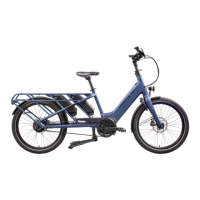MY21H01 - 32_1.0_30.07.2020
15
Overview
3.1 Description
3.1.1 RANGE
Figure 3: Visible wheel components
1Tyres
2 Rim
3 Spoke
4 Spoke nipples
5Hub
6 Valve
The wheel comprises the wheel itself, a hose with
a valve and a tyre.
3.1.1.1 Valve
Each wheel has a valve. It is used to fill the tyre
with air. There is a valve cap on each valve. The
screw-on valve cap keeps out dust and dirt.
The pedelec has either
• a classic Dunlop valve,
• a French valve (also known as a Sclaverand or
Presta valve) or
• a Schrader valve.
3.1.2 Rigid fork
Rigid forks do not feature suspension. They transfer
the used muscle and motor power to the road to
optimum effect. Pedelecs with rigid forks consume
less energy on steep roads and have a greater range
than pedelecs with adjusted suspension.
3.1.3 Brake system
Every pedelec has a hydraulic brake system. The
brake fluid is in a closed hose system. If the rider
pushes the brake lever, the brake fluid activates
the brake on the wheel.
The mechanical brakes are used as an
emergency stop system and bring the bicycle to a
halt quickly and safely in the event of an
emergency.
3.1.3.1 Disc brake
Figure 4: Brake system with disc brake – example
1Brake disc
2 Brake calliper with brake linings
3 Handlebars with brake lever
4 Front wheel brake disc
5 Rear wheel brake disc
On a pedelec with a disc brake, the brake disc is
screwed permanently to the wheel hub. The brake
lever is pushed to increase brake pressure. The
brake fluid is used to transfer pressure through
the brake cables to the cylinders in the brake
calliper. The braking force is boosted by a speed
reduction and applied to the brake linings. These
apply the brake disc mechanically. If the brake
lever is pushed, the brake linings are pressed
against the brake disc and the wheel movement is
decelerated until it comes to a stop.

